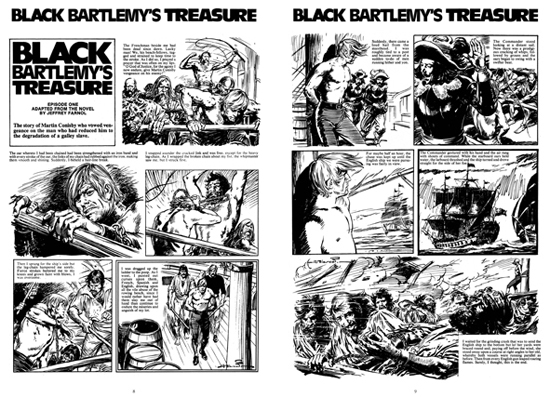Mytek the Mighty Volume 1
Published: 3 July 2025
Format: A4, 190 b/w pages, paperback with matte cover
Available via EbayMytek the Mighty Volume 2 Published: 3 July 2025
Format: A4, 180 b/w pages, paperback with matte cover
Available via EbayOrders for the pair can be made via Paypal (steve [at] bearalley.co.uk). The two volumes are £52.50 including p&p. You can order the books individually, price £27.50 including p&p. Please make sure you include your address when paying by Paypal. Please ask for overseas prices. Due to recent tariff changes, American orders should be made through Paypal in UK sterling.
Volume 3 is due for publication in September.The latest titles from Bear Alley Books begin a run of four volumes reprinting the entire run of
Valiant favourite, Mytek the Mighty. The giant robot ape ran between 1964 and 1970, the creation of Professor Arnold Boyce as the answer to rioting by Akari natives who worship a clay representation of an ape as a symbol of power and destruction.
Boyce, whose laboratory is destroyed, creates a colossal robot in the shape of the ape-god which he and local game-warden Dirk Mason use to quell the riotous actions of the natives... but the Professor's problems are just beginning, as his villainous assistant, Gogra, begins making plans to steal the robot ape and use it to march against mankind.
The kidnapped ape leaves a trail of devastation behind it, unaware of its actions... but Professor Boyce has equipped the ape with a learning brain and Mytek begins to develop self-awareness...
This classic from era when
Valiant was at its height of popularity was written by Tom Tully and drawn by Eric Bradbury, two masters of British weird menace stories, who are introduced in essays over the two volumes. Volume one contains the first of a two-part look at the career of writer
extraordinaire Tom Tully, who penned many of the most fondly remembered strips during his decades-long time as a scriptwriter. Heros the Spartan, Johnny Cougar, Kelly's Eye, The Steel Claw, Slave of the Screamer, The Toys of Doom, Raven on the Wing, Football Family Robinson, Look Out for Lefty (the strip that got
Action shut down), Death Game 1999, Harlem's Heroes, The Mean Arena, Johnny Red and twenty years of Roy of the Rovers — just some of the strips written by Tully. Volume two also takes a look at artist Eric Bradbury, using interviews with Eric in the 1990s and information from his daughter to build a picture of his life and works.
Note: Volumes three and four will follow at roughly two monthly intervals.
REVIEWS"Tom Tully packs each two-and-a-half page episode with bombastic scenes of battling mechanical monsters ... Eric Bradbury's atmospheric linework adorns the first two volumes, giving way to Bill Lacy's more dynamic style in three and four. There's much to admire about both artists, who never over-cram the action despite Tully's frequent, dense exposition."
SFX 391, May 2025.
"[I]t’s quite clear Bear Alley have put a huge amount of effort in to making these collections look as good as possible ... Not only do you get some fantastic comic tales to read: the collections
also include features on Tom Tully and Eric Bradbury, two masters of
British weird menace stories." John Freeman,
Down the Tubes, 4 July 2025












.jpg)























.jpg)



.jpg)






-550.jpg)



